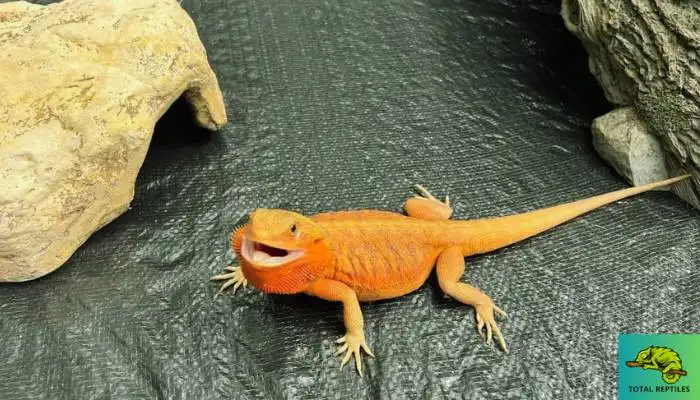Beardies bask in the sun/UVB so much that it may concern a new pet owner. This is why it is crucial to understand A to Z of bearded dragon basking.
When a beardie basks under direct sunlight or the heat lamp, it purposefully elevates its body temperature to the optimum. The process ensures healthy digestion and other significant advantages for the reptile.
In captivity, however, you are the sole provider of such an external heat source. So, know everything regarding the subject for a happy beardie by your side.

What Is Basking?
Basking indicates exposing one’s skin to an external heat source. Here is a brief version of what basking is –
- Natural sunlight provides warmth to regulate the body temperature.
- You may recognize it as sunbathing by the beach.
- Basking is a comfort behavior for ectothermic reptiles (inability to generate their own body heat).
- It enables bearded dragons to raise optimal heat for proper bodily functions.
- Pogona vitticeps or the bearded dragons in an enclosure must never be deprived of such activity, or they may die.
- The creature basks for about 10 to 14 hours a day during summer, based on the Central Australian climate, as it is native to the region.
Why Is Basking Important for Bearded Dragons?
As we have stated earlier, bearded dragons are ectothermic, meaning they rely on an external heat source to generate body temperature.
What is such a source in the wild? You have guessed it right – the sun. Its alternative is a basking or heat lamp for the captive ones.
Basking plays a massive role in maintaining the digestive system and protecting the little reptile from impaction.
Digestion
Exposure to sunlight or UVB light aids in metabolizing the calcium in the body. It is more valuable for the baby or young dragons as they require 5 to 6 times a day of eating necessity due to continued rapid growth spurt.
They bask after having a meal to obtain properly digested nutrients. Bearded dragons may not grow healthy or struggle throughout their life in captivity if the basking lamp lacks UVB.
Impaction
It refers to ingesting large food or other items that may block the intestinal tract, obstructing natural digestion. Gut impaction can be painful and life-threatening if not treated in time.
Basking thwarts the impaction and slowly allow the beardie to rehabilitate its appetite. Lastly, basking defends the reptile against metabolic bone disease and other deficits.
Temperature and Lighting Requirements
It is critical to install proper lighting in the vivarium for the successful care of a bearded dragon during daylight hours. Therefore, the owner must opt for a basking light or a heat lamp to set at one end of the tank to deliver precise radiance.
· Ideal Temperature Range for Bearded Dragons
Dragons thrive in thermal gradient environments, meaning they are fond of heat availability at different ranges throughout the day and in separate areas of the tank.
You will require two lighting systems to create that natural atmosphere. One is a UVA light, and the other is UVB. Our main focus is the latter for basking.
Here is a table to give you ideas on temperature requirements:
| Pogona vitticeps (Age) | Basking Spot |
| Adult Beardies – (12+ Months) | 95˚F-100˚F |
| Juvenile Beardies – (5-11 Months) | 100˚F-105˚F |
| Baby Beardies – (0-4 Months) | 95˚F-100˚F |
· Temperature Maintenance in the Enclosure
Proper temperature regulation with gradient promotes nurturing qualities alongside improved circadian rhythms (changes in a physical, mental, and behavioral routine within 24 hours).
So you understand the importance of monitoring the temperature in the enclosure regularly. Plus, it has to resemble the natural habitat to keep the little one content.
Keeping the basking spot temperature requirement in mind, the rest of the enclosure area should be divided into a warm and a cool zone.
The warm zone should have a 90˚F-100˚F range to rest after basking. On the other hand, the cool zone, preferably on the other side of the tank, should offer 75˚F-85˚F for the beardie to cool off after maximum heat absorption.
Remember to never go below 75˚F. Also, make sure the humidity level is at 30% up to 40% and no higher.
· Basking Bulb Wattage Requirement
Since the UVA and UVB lighting should mimic the daylight environment of the desert, each should offer from 5% to 7% radiation.
However, the heat lamp wattage differs according to the enclosure size and the dragon’s age. For instance, a 40-gallon tank will need a 100W basking light.
Basking Behavior and Signs of a Healthy Bearded Dragon
Healthy basking behavior creates a bond between the owner and the pet. Know that beardies love human interactions and will enjoy being around you when it is happy.
Here are some noticeable signs that show your dragon is healthy and content in its enclosure –

- It will not run away as you gently pick it up. If it willingly climbs on you in the process, it means the beardie is loving the attention!
- The beardie can lay on you for quite a long time, especially on your chest. It shows a feeling of trust, contentment, and well-being.
- Its willingness to climb on your shoulder is another sign that it wants to be close to you.
- A dragon will let you pick it up if it is okay with it. Otherwise, it can get slippery and jump out of your hand.
- If there is no sign of aggression, it is guaranteed that the beardie is in its happy place. Aggressive signs include hissing, bobbing head, biting, puffing out the beard, etc.
- When the daily essential functions are normal (basking, eating, pooping, and sleeping), that dragon is not stressed at all.
- A healthy and happily interacted dragon with its owner can ask him/her to hang out! Scratching the glass is one simple indication.
- Remember that a healthy bearded dragon will move around, eat, poop, and look alert. It will seem curious in the surroundings with bright eyes.
- Did you know dragons are excellent at exhibiting body language when comfortable? For instance, it can smile with a curved closed mouth or have dilated pupils with wide eyes to show curiosity.
- The dragon can wave at you to catch your attention! However, understand the context as it can also be due to a stressor in the tank it wants to be gone.
- If the dragon turns brighter in color, it generally means they are in a very good mood.
- Does the beardie close its eyes when you are near? It means the creature does not consider you a threat and feels safe around you.
- Most importantly, it will trust you enough to press flat and relax near you when tamed.
Bearded Dragon Basking with Mouth Open
When the bearded dragon in the enclosure is basking with its mouth open, a new owner is bound to seek some answers.
There are a few possible causes why the beardies exhibit this act. You may have to do some detective and attentive work to figure out which one of the following options fits your pogona.
1. It Is Regulating the Body Temperature
This is the most common action that occurs in order to regulate body heat. It is usually known as gaping, and it is perfectly normal.
Nevertheless, it also signifies the dragon is at its maximum thermal absorption. So, it gapes for the excess heat to exit through the mouth.
Although not a concerning reason, you must ensure the basking lamp is not overheating the enclosure. If you see the lizard gaping too frequently, inspect the lighting setup.

2. Beardie Is Stretching the Beard
Surely, you stretch yourself after a night’s sleep, a long drive, etc., right? Beardies are similar too.
When they stretch and puff out their beard, they may gape for a short while. This behavior tells you that the shedding season is probably ahead and is normal.
3. It Is Perhaps a Sign of Hostility
This aggressive act takes place when the lizard is mostly likely threatened by another pet (cat, dog, etc.). It responds by keeping its mouth open to express anger or fear.
Think of it like a fight or flight mode with a puffed-out chest, raised beard, and wide-opened mouth. Avoid handling your pet during these times, as it can bite you as a defense mechanism, though it is harmless.
And keep other pets or simulating objects away from the room where the beardie resides.
4. It May Be Responding to Another Beardie
While dragons are docile and solitary reptiles, they will still try to dominate over a fellow dragon in the same enclosure.
Keep in mind that beardies are territorial by nature. They will try to prove themselves to be the alpha in the vivarium by opening their mouth. As a reaction, the less dominant dragon may lose its appetite, feel stressed, and even avoid basking.
5. It Can Be a Respiratory Infection
Gaping indicates body heat regulation where the beardie keeps the mouth open for an extended period. However, the same action can be the symptom of a respiratory infection.
How do you discern which is happening? Infections can display other signs as well, such as excess lethargy, appetite loss, wheezing/crackling noise while breathing, mucus around the nose/eyes, coughing, etc.
Ensure that the humidity level is always at 40% and not above, under any circumstance.
Why Isn’t My Bearded Dragon Basking?
Basking relates to the ideal thermal temperature delivered by the heat lamp. However, other factors are liable, too, if your dragon ignores basking:
- The basking temperature is incorrect.
- Your dragon is preparing for the brumation period.
- It is still new to the enclosure to call it home.
- The beardie is intimidated by other pets.
- It is stressed by fellow dragons in the same tank.
- The dragon is reacting to external loud noises.
- It is probably shedding.
- The lizard is under depression.
- It is suffering from a certain illness.
- Gut impaction deprives the beardie of basking.
It is better to visit a certified vet to figure out the cause.
How Long Do Bearded Dragons Need to Bask After Eating?
The answer depends on several factors like lamp quality, temperature, basking spot, dragon age, etc.
Some spend hours basking after a meal while others go for fifteen minutes, take a walk around, and be back again. The more a beardie eats, the more you will likely see it under the basking lamp.
Juvenile bearded dragons have a large appetite as they grow exponentially during this stage. Therefore, they will bask more frequently.
| Age Range | Recommended Basking Duration after Eating |
| 0-3 months (Hatchling) | 1 to 2 hours |
| 3-12 months (Juvenile) | 2 to 3 hours |
| 12+ months (Adult) | 3 to 4 hours |
Also, make sure the heat lamp is of high quality and not old. Plus, try to place natural basking rocks or other objects to prevent excess heat retention. Cheaper imitation rocks can get too hot for a beardie to bask on.
Do You Keep the Basking Light on at Night?
You keep the basking lamp on during daylight hours only. Keeping the light on 24 hours a day can disrupt the lizard’s sleep cycle and suffer from hypocalcemia.
Remember that the nighttime in a desert environment is cool and dark. Replicate that atmosphere with 75˚F during sleep hours.
You may add an infrared light (IR) only if the temperature drops below 75˚F. It offers a heat gradient without blinding the beardie with intense luminosity.
We strictly do not recommend red lights despite their popular suggestions. Red light bulb is visible and can lead to stressing the dragon. It can even cause appetite loss and sleep deprivation.
Conclusion
A simple guide to bearded dragon basking is all you will require to understand 50% of its biological rhythms.
To keep your pet dragon healthy and playful around you, learn its habits like brumation, shedding, or mating seasons to give it space.
Pogona vitticeps are calm creatures but can experience mood shifts during a certain period. If you respect its preference, it will trust you unconditionally.

